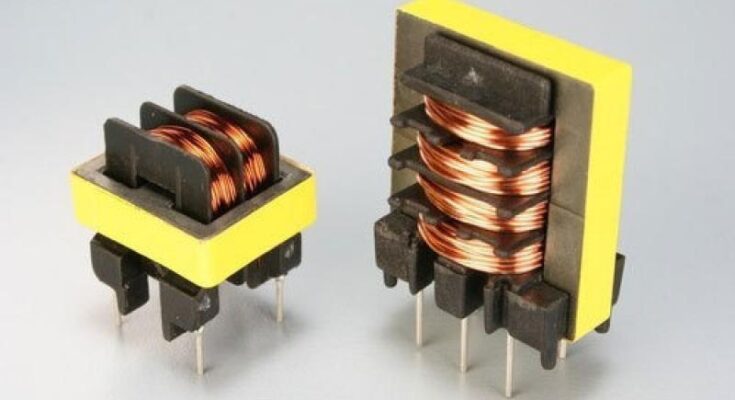Market Overview:
The global Switch Mode Power Supply Transformers market was valued at USD 2.76 billion in 2022 and expected to grow at a CAGR of 2.4% during the forecast period. Switch Mode Power Supply (SMPS) transformers play a crucial role in the functioning of switch mode power supplies. SMPS transformers are designed to efficiently convert electrical energy from one voltage level to another by using high-frequency switching techniques.
Overview
The global Switch Mode Power Supply Transformers Market is a dynamic and rapidly evolving industry that plays a crucial role in the power supply ecosystem. Switch Mode Power Supply Transformers are essential components used in various applications, including consumer electronics, telecommunications, automotive, industrial, and healthcare sectors.
Get Exclusive Sample Copy of This Report Here: https://wemarketresearch.com/sample-request/switch-mode-power-supply-transformers-market/1228/
With the increasing demand for energy-efficient devices and the growing need for compact power solutions, the global Switch Mode Power Supply Transformers Market is witnessing significant growth. The market is driven by advancements in technology, rising adoption of renewable energy sources, and the increasing integration of power electronics in various industries.
Market Dynamics:
Drivers:
Increasing Demand for Energy-Efficient Solutions: The focus on energy efficiency and the need to reduce power consumption in various applications drive the demand for SMPS transformers. These transformers offer higher efficiency compared to traditional linear transformers, making them a preferred choice for power supplies in consumer electronics, industrial equipment, telecommunications, and renewable energy systems.
Growing Adoption of Consumer Electronics: The proliferation of smartphones, tablets, laptops, and other consumer electronic devices has fueled the demand for SMPS transformers. These devices require compact and lightweight power supplies, making SMPS transformers an essential component in their design. The expanding consumer electronics market, including the Internet of Things (IoT) devices, contributes to the increasing demand.
Expansion of Renewable Energy Systems: The global shift towards renewable energy sources, such as solar and wind power, drives the demand for SMPS transformers. These transformers are crucial in power inverters used for converting DC power generated by renewable sources into AC power for distribution. The growing installations of solar panels and wind turbines worldwide directly impact the demand for SMPS transformers.
Rapid Growth in Electric Vehicles (EVs): The accelerating adoption of electric vehicles is another significant driving factor for SMPS transformers. EVs require efficient and reliable power conversion systems, including SMPS transformers, for charging infrastructure and onboard charging units. The rising demand for EVs contributes to the increased need for SMPS transformers in the automotive industry.
Industrial Automation and Robotics: The automation and robotics industry heavily rely on SMPS transformers for power supply solutions. With the automation of manufacturing processes, the demand for industrial machinery, robotics, and factory automation systems is increasing. SMPS transformers enable efficient power conversion and supply in these systems, driving their demand.
Technological Advancements: Ongoing technological advancements in SMPS transformer design, materials, and manufacturing processes contribute to market growth. Innovations in core materials, such as high-performance ferrites and advanced winding techniques, improve the efficiency, power density, and thermal performance of SMPS transformers. These advancements drive the adoption of SMPS transformers in various applications.
Increasing Focus on Miniaturization: The trend towards smaller and more compact electronic devices and equipment creates a demand for miniaturized SMPS transformers. These transformers allow manufacturers to achieve higher power density, reduce form factor, and improve portability. The demand for miniaturized SMPS transformers is prominent in sectors such as mobile devices, wearables, and IoT applications.
Regulatory Standards and Environmental Concerns: The stringent regulatory standards and environmental norms imposed by governments worldwide also influence the demand for SMPS transformers. These standards aim to improve energy efficiency, reduce greenhouse gas emissions, and promote sustainable manufacturing practices. SMPS transformers play a crucial role in meeting these requirements, leading to their increased adoption.
Emerging Markets and Infrastructure Development: The rapid industrialization and infrastructure development in emerging markets, particularly in Asia-Pacific, contribute to the growth of the SMPS transformer market. The construction of new buildings, expansion of telecommunication networks, and the establishment of manufacturing facilities drive the demand for power supplies, including SMPS transformers.
Restraints:
High Initial Costs: SMPS transformers often involve higher initial costs compared to traditional linear transformers. The advanced design, specialized materials, and manufacturing processes required for efficient power conversion can increase the cost of SMPS transformers. This cost factor can be a deterrent for some customers, especially in price-sensitive markets or industries.
Complexity in Design and Manufacturing: SMPS transformers involve complex designs and manufacturing processes due to high-frequency operation and the need for efficient power conversion. Designing and manufacturing SMPS transformers require expertise and specialized knowledge. The complexity can increase production costs and make it challenging for smaller manufacturers to enter the market.
Electromagnetic Interference (EMI): SMPS transformers, due to their high-frequency switching operation, can generate electromagnetic interference (EMI) that may interfere with nearby electronic devices or systems. Addressing EMI issues requires careful design and additional components, such as shielding and filtering, which can add complexity and cost to the overall system.
Size and Weight Limitations: While SMPS transformers offer compact and lightweight solutions compared to linear transformers, there are still size and weight limitations. In some applications, where space or weight constraints are critical, finding suitable SMPS transformers that meet the specific requirements can be challenging. This limitation can affect the adoption of SMPS transformers in certain industries or applications.
Reliability and Durability Concerns: SMPS transformers are subjected to high-frequency switching and thermal stress, which can impact their reliability and durability. The design and construction of SMPS transformers must ensure robustness and withstand the operating conditions over the product’s lifespan. Concerns about reliability and durability may hinder the widespread adoption of SMPS transformers in critical applications.
Standardization and Compatibility Challenges: The SMPS transformer market lacks strict standardization compared to traditional linear transformers. Different manufacturers may have variations in design, specifications, and performance characteristics. This lack of standardization can create challenges for system integrators, OEMs, and end-users when selecting and integrating SMPS transformers from different suppliers.
Technological Limitations: While SMPS transformers offer numerous advantages, they also have technological limitations. These limitations can include issues like voltage and current limitations, temperature constraints, efficiency drops at light loads, or challenges with power factor correction. These limitations can impact the suitability of SMPS transformers in certain applications or industries.
Regulatory Compliance: The SMPS transformer market is subject to various regulatory standards, such as safety certifications, electromagnetic compatibility (EMC) regulations, and energy efficiency requirements. Complying with these standards and obtaining the necessary certifications can be time-consuming and costly for manufacturers, especially those operating in multiple regions.
Regional Analysis:
North America: The North American region, including the United States and Canada, has a mature market for SMPS transformers. The presence of major technology companies, strong industrial automation sectors, and increasing demand for energy-efficient solutions drives the market growth. The region also sees significant adoption of SMPS transformers in data centers, telecommunications, automotive, and renewable energy applications.
Europe: Europe has a well-established electronics industry and a growing focus on energy efficiency. The demand for SMPS transformers is driven by applications in automotive electronics, industrial automation, renewable energy, and consumer electronics. The region’s strict regulations on energy efficiency and environmental standards also contribute to the market growth.
Asia-Pacific: The Asia-Pacific region dominates the global SMPS transformers market in terms of both production and consumption. China, Japan, South Korea, and Taiwan are key players in the electronics industry, driving the demand for SMPS transformers. The region’s expanding manufacturing sector, growing consumer electronics market, increasing investments in renewable energy, and government initiatives for energy efficiency contribute to market growth.
Latin America: Latin America has a developing market for SMPS transformers. The region’s growing industrialization, infrastructure development, and increasing adoption of consumer electronics contribute to the demand. Countries like Brazil, Mexico, and Argentina are the key markets in this region. However, economic volatility, political uncertainties, and infrastructure limitations can pose challenges to market growth.
Middle East and Africa: The Middle East and Africa region show promising growth opportunities for the SMPS transformer market. The increasing investments in infrastructure development, renewable energy projects, and the rising demand for consumer electronics drive the market growth. The region’s focus on energy efficiency and sustainable power solutions further enhances the demand for SMPS transformers.
Rest of the World: Other regions, including Oceania and smaller markets, contribute to the overall SMPS transformer market. These regions experience market growth due to the increasing adoption of renewable energy systems, consumer electronics, and industrial automation.
Competitive Landscape:
The global Switch Mode Power Supply Transformers market is highly competitive and fragmented with the presence of several players. These companies are constantly focusing on new product development, partnerships, collaborations, and mergers and acquisitions to maintain their market position and expand their geographical presence.
Some of the key players operating in the market are:
• Cognex Corporation
• Zebra Technologies Corporation
• Datalogic S.p.A.
• Honeywell International Inc.
• Keyence Corporation
• Sick AG
• Opticon Sensors Europe B.V.
• Newland EMEA
• Zebex Industries Inc.
• Code Corporation
• Others
Segments
By Type
• AC to DC
• DC to DC
• DC to AC
• AC to AC
By Application
• Communications
• Industrial
• Consumer Electronics
• Others
By Geography
• North America
o U.S.
o Canada
o Mexico
• Europe
o U.K.
o Germany
o France
o Italy
o Spain
o Russia
• Asia-Pacific
o Japan
o China
o India
o Australia
o South Korea
o ASEAN
o Rest of APAC
• South America
o Brazil
o Argentina
o Colombia
o Rest of South America
• MEA
o South Africa
o Saudi Arabia
o UAE
o Egypt
o Rest of MEA
Key Questions Answered in the Report:
- What will be the development pace of market? What is the growth rate of the global market?
- Who are the key manufacturers in the market space? Who are the world’s leading manufacturers?
- What are sales, revenue, and price analysis of the top manufacturers of market?
- Who are the distributors, traders, and dealers of market? What are the key factors driving the Global market?
- What are the market opportunities and threats faced by the vendors in the industries?
- What are deals, incomes, and value examinations by types and applications of the market?
- What are the primary factors driving market?
- What are the market’s advantages, disadvantages, and risks, as well as an overview of the market?
- Who are the Top Manufacturers in the Market in Terms of Sales, Revenue, and Price Analysis?
- Analysis of Industry Revenue, Sales, and Pricing, what is the difference between Equipment by region, type, and application?



